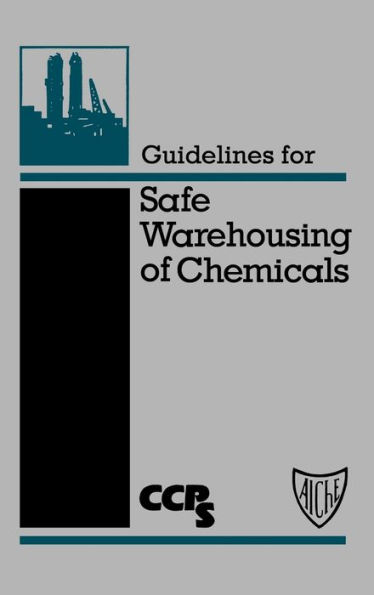Guidelines for Safe Warehousing of Chemicals / Edition 1 available in Hardcover

Guidelines for Safe Warehousing of Chemicals / Edition 1
- ISBN-10:
- 0816906599
- ISBN-13:
- 9780816906598
- Pub. Date:
- 06/15/1998
- Publisher:
- Wiley

Guidelines for Safe Warehousing of Chemicals / Edition 1
Hardcover
Buy New
$149.95Overview

Product Details
| ISBN-13: | 9780816906598 |
|---|---|
| Publisher: | Wiley |
| Publication date: | 06/15/1998 |
| Series: | CCPS Guidelines Series |
| Pages: | 192 |
| Sales rank: | 755,080 |
| Product dimensions: | 6.30(w) x 9.17(h) x 0.72(d) |
About the Author
Table of Contents
Preface.Acknowledgment.
Acronyms.
Chapter 1. Introduction.
1.1. Background.
1.2. Scope.
1.3. Purpose.
Chapter 2. Commodity Hazards.
2.1. Synopsis.
2.2. Identification of Chemicals.
2.3. Properties and Hazard Identification of Chemicals.
2.4. Systems for Commodity Classification.
2.4.1. Environmental Protection Agency.
2.4.2. National Fire Protection Association.
2.4.3. National Paint and Coating s Association's Hazardous Materials Identification System.
2.4.4. United nations (UN) and Department of Transportation (DOT) Hazardous Materials Classes.
2.5. Container and Packaging Systems.
2.6. Commodity Compatibility and Separation.
References.
Additional Reading.
Chapter 3. Administrative Controls.
3.1. Synopsis.
3.2. Safety and Risk Management Policies.
3.3. Hazard and Risk Management.
3.4. Control of Ignition Sources.
3.5. Regulatory Compliance.
3.6. Risk Management Organization.
3.7. Employee Hiring, Training and Operations.
3.7.1. Employee Hiring.
3.7.2. Training.
3.7.3. Operations.
3.8. Housekeeping.
3.9. Inventory Management.
3.10. Management of Change.
References.
Additional Reading.
Chapter 4. Employee Safety and Health.
4.1. Synopsis.
4.2. Policy.
4.3. Administrative and Engineering Controls.
4.3.1. Administrative Controls.
4.3.2. Engineering Controls.
4.4. Hazard Communication.
4.4.1. Labels.
4.4.2. Material Safety Data Sheets.
4.4.3. Employee Information and Training.
4.5. Personal Protective Equipment.
4.5.1. Implementing a PPE Program.
4.5.2. Selecting PPE Program.
4.5.3. Chemical Protective Clothing.
4.5.4. Foot Protection.
4.5.5. Head Protection.
4.5.6. Eye and Face Protection.
4.5.7. Hand Protection.
4.5.8. Respirators.
4.5.9. Respirator Selection.
4.5.10. Respirator Usage.
4.5.11. Training.
4.5.12. Maintenance and Inspection.
4.6. Safety Equipment.
4.7. Emergency Response Training.
4.7.1. Emergency Spill Response.
4.7.2. Manual Fire Fighting.
4.7.3. First Aid.
References.
Additional Reading.
Chapter 5. Site Considerations.
5.1. Synopsis.
5.2. Health and Environmental Exposure.
5.2.1. Baseline Environmental Assessment.
5.2.2. Population Proximity, Density, and Sensitivity.
5.2.3. Warehouse Truck Traffic.
5.2.4. Highly Sensitive Environments.
5.2.5. Surface Water, Ground water, and Soil Permeability.
5.3. Natural Peril Exposures.
5.3.1. Earthquake.
5.3.2. Flood.
5.3.3. Hurricanes.
5.3.4. Tornadoes.
5.3.5. Lightning.
5.3.6. Arctic Freeze.
5.4. Exposures from Surrounding Activities.
5.4.1. Adjacent Facilities, Airports, Highways, and Railroads.
5.4.2. High Pressure Flammable Gas and Liquid Transmission Lines.
5.4.3. Riot and Civil Commotion.
5.5. Emergency Responders.
5.6. Adequacy and Reliability of Public Utilities.
References.
Additional Reading.
Chapter 6. Design and Construction.
6.1. Synopsis.
6.2. Construction Documents-Approvals and Permits.
6.3. Means of Egress.
6.3.1. travel Distance.
6.4. Environmental Protection.
6.4.1. Containment and Drainage Capacity Considerations.
6.4.2. Warehouse Floor System.
6.4.3. Concrete Criteria.
6.4.4. Surface Preparation.
6.4.5. Coating and Sealers.
6.4.6. Maintenance and Repair of the Floor.
6.4.7. Airborne Effluent.
6.5. Fire Mitigation Construction Features.
6.5.1. Fire-Rated Separations.
6.5.2. Protection of Openings and Penetrations.
6.5.3. Through-Penetrations.
6.5.4. Heat and Smoke Venting.
6.5.5. Powered Ventilation Systems.
6.5.6. Emergency and Standby Power Systems.
6.6. Deflagration Prevention and Mitigation.
6.1.1. Temperature Control.
6.6.2. Gas and Vapor Control.
6.6.3. Sources of Ignition.
6.6.4. Spatial Separation.
6.6.5. Damage Limiting Construction.
6.7. Natural Peril Mitigation.
6.7.1. Earthquake.
6.7.2. Flood.
6.7.3. Lightning.
6.7.4. Windstorm, Hurricane, and Tornado.
6.8. Security Features.
6.9. Outdoor Storage.
References.
Additional Reading.
Chapter 7. Fire Protection Systems.
7.1. Synopsis.
7.2. Storage Considerations.
7.3. Fire Control, Suppression, and Extinguishing Systems.
7.3.1. Fire Control.
7.3.2. Fire Suppression.
7.3.3. Fire Extinguishment.
7.3.4. Fire Extinguishers.
7.4. Fire Detection and Alarm Systems.
References.
Additional Reading.
Chapter 8. Inspection, Testing, and Maintenance Programs.
8.1. Synopsis.
8.2. Inspection and Test Programs.
8.2.1. Program Objectives.
8.2.2. Critical Equi9pment and Construction Features.
8.2.3. Inspection and Test Program Elements.
8.2.5. Maintenance Procedures.
References.
Additional Reading.
Chapter 9. Emergency Planning.
9.1. Synopsis.
9.2. Loss Scenarios.
9.3. Plan Objectives.
9.3.1. Employees.
9.3.2. Surrounding Population.
9.3.3. Environment.
9.3.4. Property Protection and Business Interruption.
9.4. Plan Development.
9.5. Plan Elements.
9.5.1. Policy Statement.
9.5.2. Scope and Objectives.
9.5.3. Pre-Incident Planning.
9.5.4. Incident Response.
9.6. Emergency Spill Response.
9.6.1. Planning.
9.6.2. Responding to a Hazardous Material Spill.
9.6.3. Cleanup.
9.6.4. Reporting.
9.6.5. Public Response.
9.7. Regulations and Resources.
9.7.1. U.S. Regulations.
9.7.2. CMA Responsible Care Program.
References.
Additional Reading.
Chapter 10. Selected research and Discussion Topics.
10.1. Synopsis.
10.2. Commodity Hazards and Fire Protection Systems.
10.3. Design and Construction.
Appendix A. Summary of NFPA 704 Marking System.
Appendix B. Summary of HMIS.
Appendix C. United Nations and U.S. Department of Transportation Hazardous Materials Classes.
Appendix D. Additional Resources.
Glossary of Terms.
Index.
